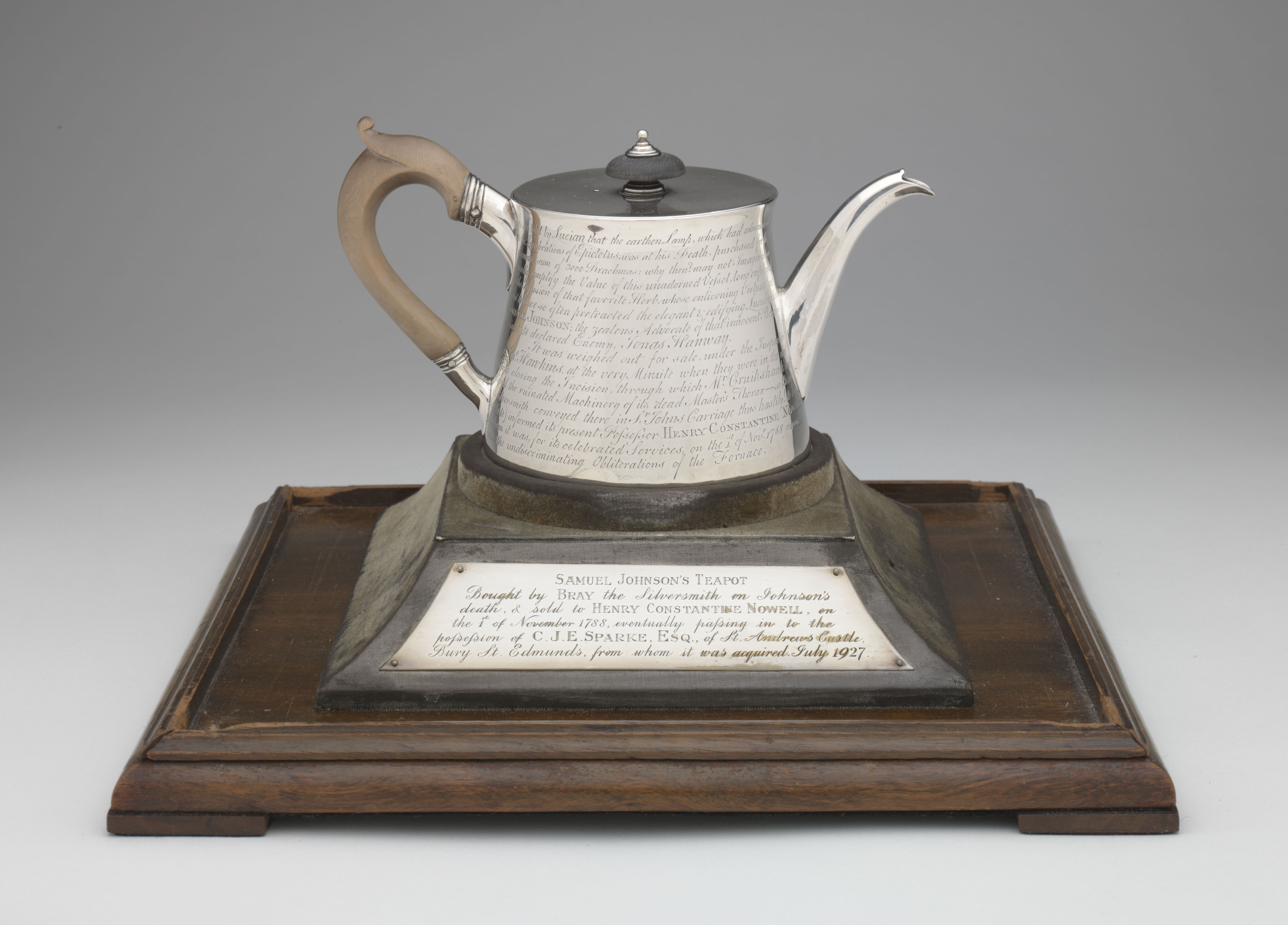If, like me, you love a hot brew, then ‘Dr Johnson’s teapot’, now held at the Houghton Library in Harvard University, is a must-see. Dating from c. 1765-68, this item was certainly used at 17 Gough Square, and certainly belonged to the house’s owner, Dr Samuel Johnson. Less certain, however, is whether the pot was intended for the making of tea or coffee. Having first been purchased by Henry Constantine Newell, the pot was acquired by the American collector and Johnson enthusiast A. Edward Newton in 1927, at the height of Anglophile literary collecting in the States. By this time, the coffee-pot seems already to have been identified as a teapot, because it was used at a tea-party to recreate the Johnsonian Literary Club at Newton’s home, Oak Knoll, Boston, on December 11th 1932, complete with servants in eighteenth-century costume. It continues to be described as a teapot in the Houghton Library’s online exhibition, despite the fact that the exhibit also includes the manuscript in which Johnson gifts it as a coffee-pot to his longstanding black manservant Francis Barber.
Speculation over intended beverage aside, the pot shows unmistakeable signs of the processes that household equipment has to go through in order to become a literary relic. Most strikingly, the body of the pot has been engraved with an extensive inscription, which reads as follows:
It was weighed out for sale, … at the very Minute when they were in the next Room closing the incision through which Mr Cruikshank had explored the ruinated Machinery of its dead Master’s thorax – so Bray (the silversmith conveyed there in Sr. John’s Carriage thus hastily! to buy the Plate) informed its present Possessor Henry Constantine Newell by whom it was, for its celebrated Services, on the 1st of Novr. 1788 rescued from the undiscriminating Obliterations of the Furnace.
The wonderfully macabre story the coffeepot suggests that, for its proudly verbose owner, the pot stood in both as an eyewitness and a substitute for the ‘ruinated Machinery’ of Johnson’s body. Unlike the dead body, it was something that could be ‘rescued’ from ‘undiscriminating Obliteration’ whether of the furnace or the grave, saved from the mortal wreckage of genius to narrate its continuing cultural importance to posterity. And this is precisely what happened.
The continuing question as to whether this is a tea or coffee-pot is instructive, because arguably it points to something else that it was supposed to be doing. One might account for the confusion by noting the apparent variant spelling in the manuscript of the will of ‘coffea’, and that the manuscript itself, read at speed, could be construed as a crossing-out, followed by the word ‘tea’, but this is fairly far-fetched. It is more likely that the coffeepot ought to have been a teapot. It ought to have been a teapot because, as any reader of James Boswell’s Life of Johnson (1791) knows, Johnson and Boswell drank coffee at the Turk’s Head Coffee-house, and not at home. Perhaps in 1927 tea seemed more English; it certainly associated better with American temperance culture, and with a reading of Boswell who mentions Johnson taking tea some thirteen times in the Life and famously opens his Journal of A Tour to the Hebrides with Samuel Johnson LLD (1785) with a vignette of Johnson drinking tea with himself and his wife on his arrival in Edinburgh in August 1773:
My wife had Tea ready for him, which it is well known he delighted to drink at all hours, particularly when sitting up late….He showed much complacency upon finding that the mistress of the house was so attentive to his singular habit; and as no man could be more polite when he chose to be so, his address to her was most courteous and engaging, and his conversation soon charmed her into a forgetfulness of his external appearance.
This scene was important enough for contemporaries to be illustrated by Thomas Rowlandson in 1786; after all, it describes the way in which the uncompromisingly English Johnson could be made at home in a foreign country and domesticated (in both senses of the word) in someone else’s house. Qua teapot, the coffeepot thus functions as what I might call a portable writer’s house museum – it had the capability of travelling across the Atlantic to act as precursor and facilitator of a transatlantic version of the Johnsonian salon. Ultimately, the drinking of tea made Johnson at home across the Atlantic, and allowed his American admirers to be at home with him. Now, I don’t know about you, but I rather fancy a cuppa…
Also on Johnson see https://www.open.ac.uk/blogs/literarytourist/?p=242 and https://www.open.ac.uk/blogs/literarytourist/?p=195 and https://www.open.ac.uk/blogs/literarytourist/?p=190

